yeovil at War
Frederick Henry John Phillips
Drowned when the SS Transylvania was torpedoed
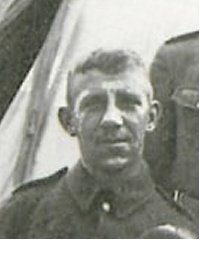 Frederick
Henry John
Phillips was
born in Yeovil
in the summer of
1885, the son of
glover Frederick
William John
Phillips (b1865)
and Ann née
Lodge (b1864).
Frederick and
Ann were to have
three sons;
Edwin James
Arthur
(1883-1969),
Frederick and
Stanley (b1893).
Frederick
Henry John
Phillips was
born in Yeovil
in the summer of
1885, the son of
glover Frederick
William John
Phillips (b1865)
and Ann née
Lodge (b1864).
Frederick and
Ann were to have
three sons;
Edwin James
Arthur
(1883-1969),
Frederick and
Stanley (b1893).
In the 1891 census Frederick and Ann, together with their two sons, Edwin and Frederick, were listed at 69 Reckleford located between the Nag's Head Inn and Court Ash Terrace (see Gallery).
(From later newspaper reports in which he is referred to as "Private H Phillips" and his wife as "Mrs H Phillips" it is almost certain that he was known as Henry, or Harry, rather than Frederick, probably to distinguish him from his father.)
By the time of the 1901 census the family were living at 12 Kiddles Lane (today's Eastland Road). Frederick Snr gave his occupation as a leather slaker. 15-year old Frederick Jnr was working but his trade was illegible in the census return although it is known that he worked in a glove factory.
In the summer of 1906 Frederick married Mary Ellen Chant (b1888) at Yeovil. They were to have five children; Ella Blanch, Elsie, Ivy, Edna and Reg. The family lived in Kiddles Lane and took in several boarders.
Frederick was a member of the Yeovil Salvation Army Band (see Gallery) and also a member of the Yeovil Men's Voluntary Aid Detachment (VAD). Following the end of the Boer War, the War Office was concerned that in the event of another war the medical and nursing services wouldn’t be able to cope sufficiently. The peacetime needs of a standing army, in relation to medical care, were very small and specific, and to find thousands of trained and experienced personnel at very short notice, without the expense of maintaining them in peacetime, was a difficult problem to overcome. A new Territorial scheme of 1907 solved some of those problems, and opened up new possibilities of co-operation between voluntary agencies and the Army, and in 1909 the War Office issued its ‘Scheme for the Organisation of Voluntary Aid in England and Wales,’ which set up both male and female Voluntary Aid Detachments to fill certain gaps in the Territorial medical services. By early 1914, 1,757 female detachments 519 male detachments had been registered with the War Office.
In the 1911 census Frederick and his family, as well as four boarders, were listed at 36 Kiddles Lane. Frederick gave his occupation as a leather dresser.
 It
is not known
when Frederick
enlisted,
although it is
known that he
enlisted at
Taunton "soon
after the
outbreak of
hostilities".
With his medical
training in the
Yeovil Men's
Voluntary Aid
Detachment it is
not surprising
that Frederick
enlisted as a
Private in the
Royal Army
Medical Corps.
His Service
Number was
52010.
It
is not known
when Frederick
enlisted,
although it is
known that he
enlisted at
Taunton "soon
after the
outbreak of
hostilities".
With his medical
training in the
Yeovil Men's
Voluntary Aid
Detachment it is
not surprising
that Frederick
enlisted as a
Private in the
Royal Army
Medical Corps.
His Service
Number was
52010.
Although his service career is generally unknown, it was later reported that he saw considerable service in France "and had become invalided home as a result of illness".
By May 1917 Frederick was in France and about to sail to join the British Salonika Force in Greek Macedonia. He boarded the SS Transylvania at Marseilles, France, as part of a full complement of troops.
The SS Transylvania was a passenger liner of the Cunard subsidiary Anchor Line. Completed just before the outbreak of war, the Transylvania was taken over for service as a troopship upon completion. She was designed to accommodate 1,379 passengers but the Admiralty fixed her capacity at 200 officers and 2,860 men, besides crew, when she was commissioned in May 1915.
On 3 May 1917, the Transylvania sailed from Marseille to Alexandria with a full complement of troops, escorted by the Japanese destroyers Matsu and Sakaki.
At 10 am on 4 May 1917 the Transylvania was struck in the port engine room by a torpedo fired by the German U-boat U-63 under the command of Otto Schultze. At the time the ship was about 2.5 miles (2.2 nmi; 4.0 km) south of Cape Vado near Savona, in the Gulf of Genoa. The Matsu came alongside the Transylvania and began to take on board troops while the Sakaki circled to force the submarine to remain submerged.
Twenty minutes later a second torpedo was seen coming straight for the Matsu, which saved herself by going astern at full speed. The torpedo hit the Transylvania instead, which sank immediately. Ten crew members, 29 army officers and 373 soldiers lost their lives including Frederick Phillips. He was 32 years old.
Many bodies of victims were recovered at Savona and buried two days later, in a special plot in the town cemetery. Others are buried elsewhere in Italy, France, Monaco and Spain. Savona Town Cemetery contains 85 Commonwealth burials from the First World War, all but two of them casualties from the Transylvania. Within the cemetery is the Savona Memorial which commemorates a further 275 casualties, including Frederick, who died when the Transylvania sank, but whose graves are unknown. Transylvania was discovered by the Italian Carabinieri on 7 October 2011 off the coast of the island of Bergeggi at a depth of about 630 metres.
In its edition of 1 June 1917 the Western Gazette reported "Mrs H Phillips, of 23 Newtown, Yeovil, has received a telegram stating that her husband, Private H. Phillips, of the R.A.M.C., is reported as “missing believed drowned” on the 4th May. Private Phillips, who joined the Army soon after the outbreak of hostilities was well-known and highly respected in the district, and was a member of the Yeovil Men’s V.A.D. He had seen considerable service in France, and had become invalided home as a result of illness. He was also a prominent member of the Salvation Army Band, and when home on leave had played on several occasions. Private Phillips was, prior to enlisting, employed in one of the glove factories in the town. His brother, Private E Phillips, who was also a member of the Men’s V.A.D., joined the Army at the beginning of the year, and is now in France. Much sympathy is felt for the wife and family."
The Western Gazette then reported, in its edition of 27 July 1917 "Recently it was announced that Private H Phillips was believed to have been drowned, in consequence of the torpedoing of the Transylvania. During the past week a report affirming that belief has been received, and in view of this a memorial service was conducted by Adjutant Newton at the Salvation Army Temple on Sunday evening, the deceased having been a member of the well-known band of the local corps - Bandmaster Bicknell sympathetically alluded to the sad event on behalf of the band and corps, expressed sincere sympathy with the deceased’s wife and parents in their time of sorrow - Adjutant Newton gave an address in the course of which he paid high tribute to the deceased’s qualities."
Frederick Henry John Phillips' name is inscribed on the War Memorial in the Borough.
gallery
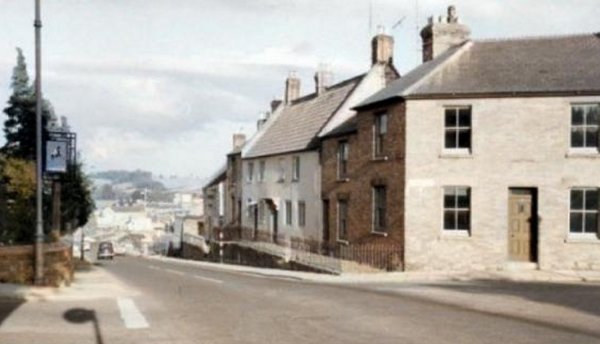
From the Cave
Collection
(colourised),
Courtesy of South Somerset Heritage Collection
This photograph, taken in the early 1960's, looks down Reckleford Hill from the Avenue / Court Ash crossroads. The entrance to the Avenue is at left with the sign of the Black Horse evident on the corner. At right is the entrance to Court Ash Terrace - this section of Court Ash was closed a short while after this photograph was taken and the whole area including the top section of Court Ash as well as all the buildings to the Nags Head Inn at the end of the terrace was redeveloped as part of the widening of Reckleford. The Phillips family lived in the central white house with the larger door canopy during the 1890s.
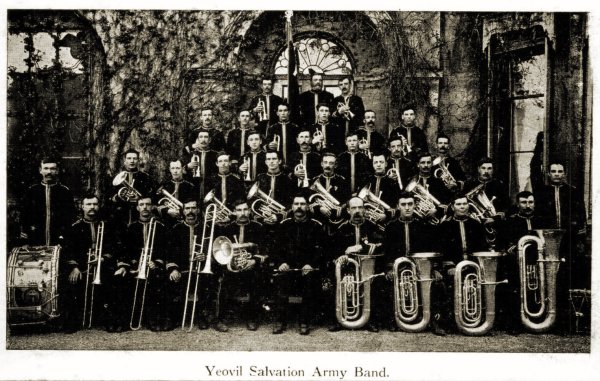
From my
collection
AA postcard of the Yeovil band of the Salvation Army dating to around 1908. It is likely that Frederick is in this photograph.
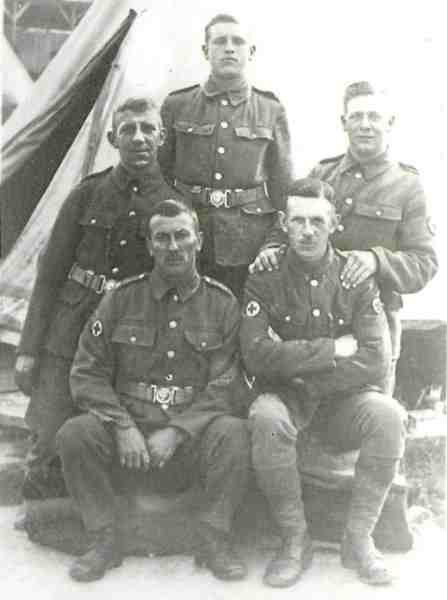
Courtesy of
Derek Phillips
Frederick Phillips, centre left, photographed with other soldiers of the Royal Army Medical Corps.
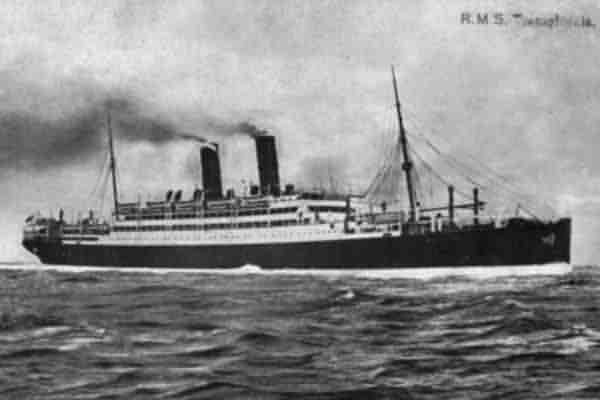
SS Transylvania was a passenger liner of the Cunard subsidiary Anchor Line. Completed just before the outbreak of World War I, Transylvania was taken over for service as a troopship upon completion. She was designed to accommodate 1,379 passengers but the Admiralty fixed her capacity at 200 officers and 2,860 men, besides crew, when she was commissioned in May 1915. She was torpedoed and sunk on 4 May 1917 by the German U-boat SM U-63 at coordinates 44°15′N 8°30′E while carrying Allied troops to Egypt and sank with a loss of 412 lives.
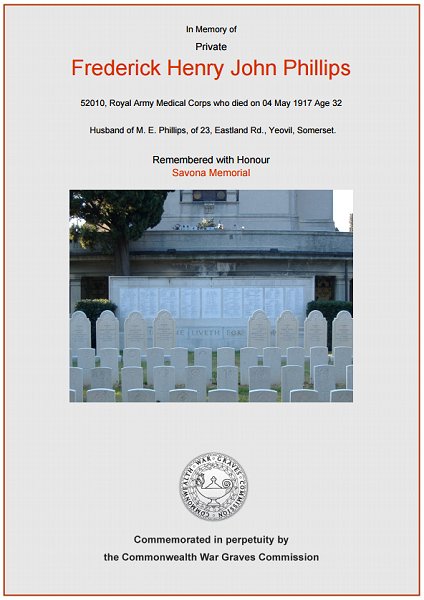
The Commonwealth War Graves Commission certificate in memory of Frederick Phillips.